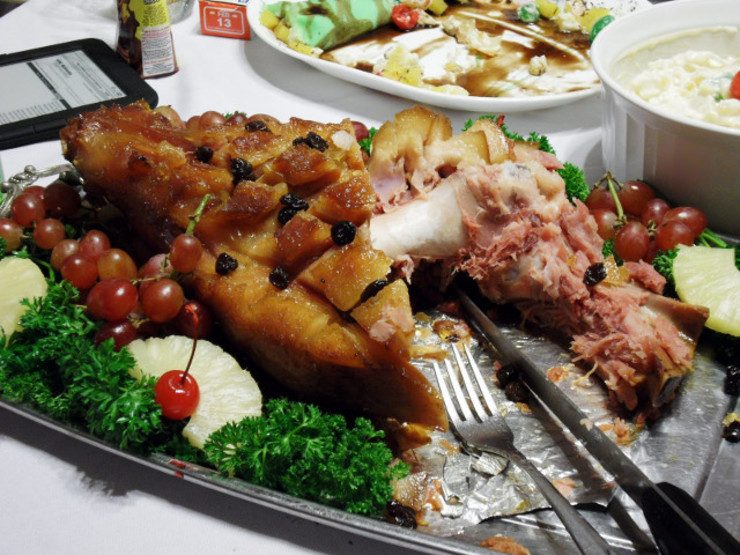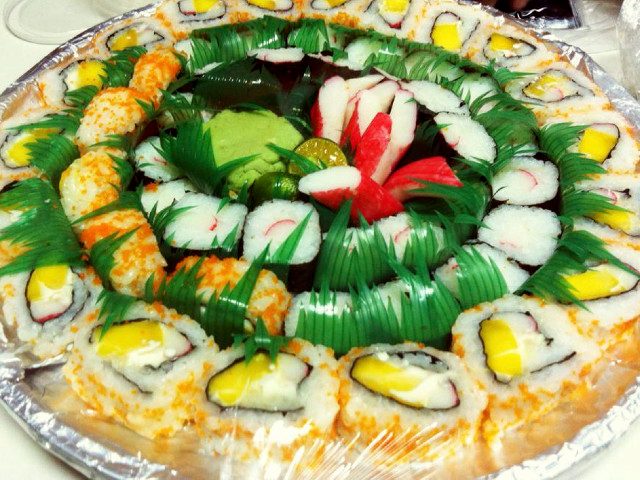SUMMARY
This is AI generated summarization, which may have errors. For context, always refer to the full article.

MANILA, Philippines – It’s the time of the year when Rosalie Busilig gets to meet her relatives over a hearty dinner, peppered with nostalgic chitchat.
On the table: a plate of chicken afritada (a dish of slices of chicken stewed in tomato sauce, onions and carrots), and two of mostly-sought food on Christmas Eve: fruit salad and sweet ham.
“It’s a tradition, and our children would always look for it,” said 30-year-old Busilig, a caretaker in an exclusive beach club in Nasugbu, Batangas.
Noche Buena without fruit salad and ham, breaks the tradition, where extended families come over for once a year, Busilig said.
Like the household of Busilig, most Filipino families prepare Noche Buena meals meant to be shared with relatives to celebrate Christmas.
Noche Buena (Christmas Eve with traditional family dinner) is common in predominantly Roman Catholic countries like the Philippines, and dates back to Roman celebrations of the rebirth of the sun God, Sol Invictus, after he kicked the meteorological bucket at winter solstice.
Noche Buena is a family-oriented affair, and follows Misa de Gallo (Rooster’s Mass).
For majority of Filipino households, the dining table on Christmas Eve is rarely never without these: fruit salad, ham, queso de bola (edam cheese), spaghetti, among other holiday favorites.
Thus, keeping up with the tradition means shelling out sums from every family’s hard-earned money.
Ham is a must

So every December, Busilig, together with her partner, 38-year-old Henry Bautista, apportion P1,000 ($22.34)* to buy the supermarket items they need on Christmas Eve.
Prices of Noche Buena items have increased over the years.
Note the price of ham, a Noche Buena favorite. A kilo of King Sue sweet ham in 2011 was P350 ($7.82) in 2011. Today, its suggested retail price (SRP) hovers at P430.50 ($9.62), according to the Department of Trade and Industry (DTI).
An association of importers pointed Manila ports’ congestion as a possible reason why prices of these products increased.
“The delay in delivering these goods from the port to the suppliers then to retailers like supermarkets puts ordinary consumers at the raw end of the deal,” Mary Zapanta, president of the Aduana Business Club, said in October.
To meet consumer demands, though, supermarkets seasonal items sell below suggested price tags. SM’s Hypermart, for instance, sells the same ham brand for P410 ($9.16).
“During the holidays, we try our best to make all Noche Buena items available in our stores while keeping our prices as competitive as possible,” Frances Corsiga, head of SM Food Retail, told Rappler.
The increase may mean nothing for a middle class individual who earns an average of P65,631 ($1,466.12) per month.
But for Busilig, who earns P303 ($6.77) per day as a resort caretaker, that means fewer choices on what to buy for Noche Buena.
Finding food for Christmas Eve was harder last year for Busilig, when her partner, Bautista, had no work. Both have been living together for 14 years now, with children ages 13 and 8.
In many cases, though, they set aside money to buy ham, which they feel is what completes the yearly gathering of relatives from his partner’s side.
Bautista, who now has work as a time keeper in a government office in Calaca, Batangas, earns P360 ($8.04) a day, which could be good news to the partner’s household this coming Christmas.
Binds the family
“Yearly, we change the menu. This time, it’s going to be Asian so that the budget won’t exceed,” he told Rappler. His P2,000-budget ($44.68) caters to 8 adults and two children in his home in Muntinlupa City.

According to DTI Undersecretary Victorio Mario Dimagiba, Noche Buena products increased by 0.72% to 28.67% compared to their 2013 prices.
Weekly, the DTI publishes on newspapers a weekly price watch for selected seasonal items, warning supermarkets against the unscrupulous jack up of consumer products. It is an effort to maintain prices within the market range.
Soaring prices of Noche Buena items are easily cushioned by relatives who help though, Busilig said.
As many relatives flock to their home in Batangas for a reunion, each extended family member is assigned to bring something that would complete the Christmas gathering.
“That’s why we don’t need to spend all to feed them,” Busilig said.
Anywhere in the Philippines, the practice is strikingly similar – which in most cases – helps ease the burden of buying expensive Christmas Eve products.
In Davao City, 25-year-old chemical engineer Karlo James Bringas, agrees.
Every year, Bringas said he contributes between P500 ($11.17) and P750 ($16.75) to what his parents spend when buying Noche Buena items from the supermarket.
What they’re expecting on the table a week from now: arroz valenciana (a Latin American rice dish with meat and garnishes of vegetables cooked in either beer or white wine); embutido (meat loaf); rice, and dessert.

Filipinos are big spenders during the holidays, according to Kantar WorldPanel. In 2013, they spent an average of P16 ($0.36) more across seasonal items.
Also, according to the latest Pulse Asia survey results released December 15, more Filipinos (34%) see a more prosperous Christmas and New Year celebration with their families compared to last year (22%). The percentage of Filipinos with this sentiment has increased in general, and also in Metro Manila, Visayas, and those from classes A, B, C, and D.
About 14% though expect a poorer holiday season for their families. The percentage of Filipinos who shares this view has declined in the past year at the national level, as well as in the Visayas and class D.
So whether or not prices of Noche Buena make it hard for many Filipinos to purchase them, there is no stopping Filipinos to spend for these items. They say there’s nothing more than this that unites the family.
“Familiar food is the kind of glue that holds the occasion together,” Bringas said. – Rappler.com
*$1 = P44.77
Add a comment
How does this make you feel?





There are no comments yet. Add your comment to start the conversation.